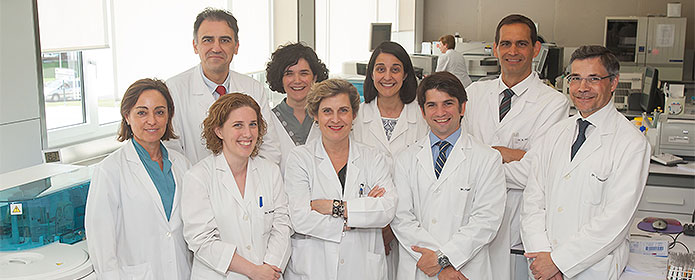Blood test detects several genetic mutations implicated in the most common lung cancer
The localization of certain genetic alterations in the patient's circulating DNA makes it possible to know the prognosis of the patient's tumor disease and to carry out frequent and non-invasive follow-up.

A blood test can now detect the presence of several genetic mutations involved in the most common form of lung cancer. These are alterations whose detection is essential in order to select the most effective treatment and to know the prognosis of the disease, and whose analysis is currently performed by means of cytology and biopsies of the tumor tissue.
A team of researchers from the Clínica Universidad de Navarra and the CIMA (research center Applied Medicine) have analyzed, in circulating DNA obtained from a sample blood sample, several EGFR (epidermal growth factor receptor) gene mutations in patients with non-small cell lung cancer, a tumor that accounts for 85% to 90% of all lung cancers.
The Service of Biochemistry of the Clínica Universidad de Navarra has already incorporated this technique to its portfolio of services in partnership with the CIMA LAB Diagnostics of the University of Navarra.
Award-winning and published studyThe authors of this scientific study, led by Dr. Álvaro González Hernández (director laboratory Biochemistry of the Clinic) and Dr. José Luis Pérez Gracia (co-director of the Central Clinical Trials Unit), were Dr. Estíbaliz Alegre of laboratory of Biochemistry of the Clinic and Dr. Juan Pablo Fusco, of department of Oncology, among others.
The work has recently received a award during the annual meeting of the association American Clinical Chemistry held in Philadelphia (Pennsylvania, USA). The results of the research have just been published in the scientific journal Tumor Biology, the official publication of the International Society for Biology and Biomarkers.
Different mutations, different treatmentsThe presence of EGFR activating mutations makes it possible to select patients who are candidates for therapy with EGFR inhibitor drugs, which obtain a better response than traditional chemotherapy. In contrast, the presence of the p.T790M mutation in the same gene is associated with resistance to these treatments.
In the present study, carried out in patients with non-small cell lung cancer with EGFR gene mutations, these mutations have been detected in circulating DNA obtained from blood samples. The analysis of circulating DNA in peripheral blood was performed using the digital PCR technique, test with a high sensitivity that allows detection of 1 mutated copy among 20,000 unmutated copies.
Circulating DNA is genetic material that is released by all cells - both healthy and tumor cells - into body fluids, including the bloodstream. This DNA reflects at the molecular level the characteristics of the cells from which it originates. Therefore, its analysis in a sample blood sample allows molecular information to be obtained about the tumor being studied. In addition, the DNA reflects the mutations present throughout the tumor, not only in a sample of the tumor obtained by biopsy or cytology, "it is a more representative view of the whole tumor, more global", describes Dr. Estíbaliz Alegre.
Circulating DNA differences vs. biopsyThe conventional method for the detection of these mutations by biopsy or cytology has the disadvantage of the difficulty of obtaining samples and the invasiveness of the procedures required to obtain them. In comparison, the analysis of circulating DNA is a non-invasive test that allows periodic analysis to monitor the evolution of the disease in the patient. Therefore, this analysis can be an important complement to biopsies and cytology in the management of oncology patients.
Digital PCR has also made it possible to detect mutations in the blood that were not previously localized in the tumor samples analyzed. This may be due to the heterogeneity of this tumor subject , which means that different areas of the tumor tissue may present different mutations and that, therefore, the tumor may present alterations that are not localized in the area from which the biopsy sample was obtained.
The research has also revealed that, thanks to the digital PCR technique, it is possible to quantify the issue of mutated (with the alteration) and non-mutated gene copies. "In this work we have observed that the higher the issue of mutated copies detected in plasma, the worse the prognosis of the disease. But we have also found that the higher the issue of non-mutated copies, the worse the prognosis," warns Dr. Alegre. "This seems to indicate that gene amplification occurs in the tumor, so that more copies of the gene are released into circulation, so that the more mutated or non-mutated copies circulate, the worse the prognosis for that patient".
Detecting the disease before it is "seen".subject The analysis of circulating DNA in peripheral blood is performed using the digital PCR technique, "a tremendously sensitive and very specific test that allows us to detect tumor-specific alterations in any of the patient's fluids: blood, urine, bronchoalveolar lavage....", explains the director of the Clinic's Clinical Unit Genetics , Dr. Ana Patiño. Therefore, she specifies, "it is not an invasive procedure , it can be repeated as many times as necessary and it is very cost-effective because it can be performed in a serial manner for patient follow-up".
The great advantage offered by this diagnostic technique lies in the fact that it is able to detect the disease, before it is discovered by a radiological test . "It usually happens that patients who progress in their disease are only diagnosed when a standard imaging test can detect the new tumor; however, with this very sensitive technique subject , we can closely monitor the patient and anticipate the conventional diagnosis, detecting the disease at a time when it is not yet a serious health problem.
